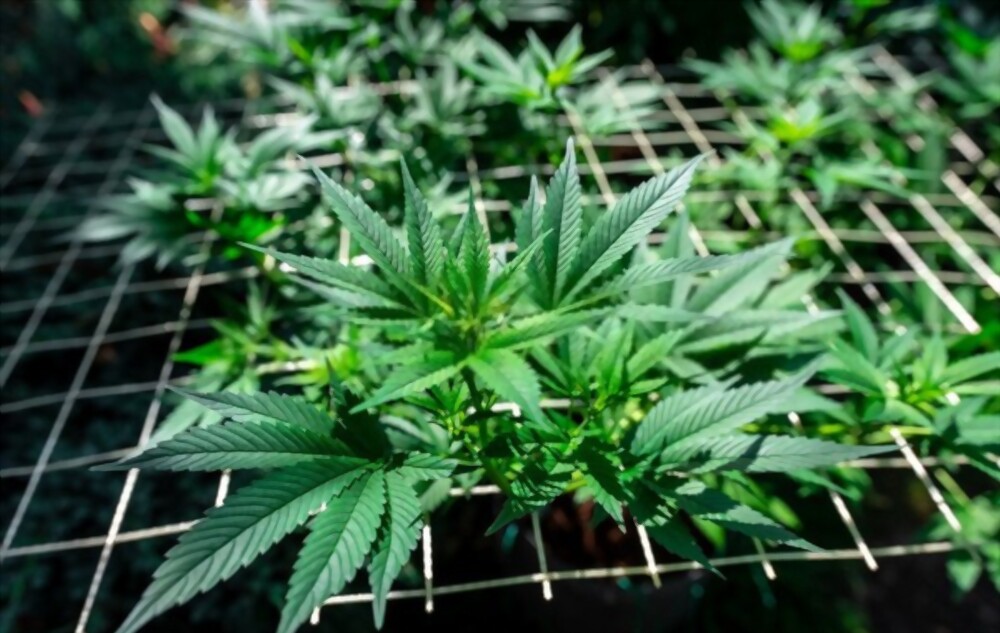🔥 Website for Sale - Contact Us
The ScrOG method, also known as the “Screen of Green,” is a powerful technique that helps cannabis plants make the most of available light and space. This approach not only enhances your plant’s growth but also helps improve yield.
In our ScrOG for Beginners guide, we provide a comprehensive overview of the Screen of Green (ScrOG) method and its benefits, and a step-by-step process to get you started.
II. What is ScrOG?
Screen of Green, or ScrOG, is a popular cannabis cultivation technique that focuses on optimizing plant growth and maximizing yields. This method involves using a horizontal screen or netting to train the plants to grow horizontally, ensuring that they receive uniform light exposure and adequate airflow. The ScrOG technique helps to promote the growth of bud sites and keeps the plant canopy even, resulting in a more consistent harvest.
The ScrOG method was developed as a solution to the common challenges faced by indoor cannabis growers, such as limited space and uneven light distribution. With traditional vertical growth, the main cola or top bud tends to receive the majority of the light, leaving the lower branches underdeveloped. ScrOG addresses this issue by directing the plants to grow laterally, allowing all parts of the plant to receive equal light and encouraging more bud production throughout the plant.
In addition to its yield-enhancing benefits, the ScrOG method also helps improve plant health by increasing airflow and reducing the risk of mold and mildew. This is particularly beneficial in indoor grow environments, where humidity levels can be harder to control.
III. Getting Started with ScrOG
A. Choosing the right cannabis strains for ScrOG
Selecting the right cannabis strains is crucial for success with the Screen of Green method. While most strains can be grown using ScrOG, some are better suited for this technique due to their growth patterns and characteristics. Here are a few factors to consider when choosing a cannabis strain for your ScrOG setup:
Growth structure: Ideally, you want to select strains that have a strong branching structure and a tendency to produce multiple bud sites. Indica-dominant strains or hybrid strains with a balanced mix of indica and sativa genetics are generally well-suited for ScrOG because of their bushy growth and shorter stature. However, some sativa-dominant strains can also be successfully grown using ScrOG with careful training and pruning.
Stretch during flowering: Some cannabis strains can almost double or triple in size during the flowering stage. This is known as “stretch.” Strains with minimal stretch are preferable for ScrOG, as they will require less height adjustment and maintenance during the flowering stage.
Flowering time: Strains with shorter flowering times are often more manageable in a ScrOG setup, as they require less time and effort to maintain during the flowering stage. However, if you are willing to invest the time and attention, longer-flowering strains can also be grown successfully with ScrOG.
Mold and pest resistance: Strains with good mold and pest resistance are advantageous in a ScrOG system, as they are less likely to succumb to these common issues. Proper airflow and maintenance can help prevent these problems, but selecting resistant strains provides an added layer of protection.
Some popular cannabis strains that have proven to perform well in a ScrOG setup include:
- Blue Dream (Hybrid)
- White Widow (Indica-dominant hybrid)
- Girl Scout Cookies (Hybrid)
- Gorilla Glue #4 (Hybrid)
- Northern Lights (Indica)
Remember that every grower’s environment, skill level, and preferences are different, so it’s essential to experiment with various strains to find the ones that work best for you and your ScrOG system.
B. Preparing your grow room or space for the Screen of Green method
Before you start implementing the ScrOG technique, it’s essential to prepare your grow room or space to support this method effectively. Here are some key steps to help you create the optimal environment for a successful Screen of Green setup:
Choose the right location: Find a space that can accommodate the horizontal growth pattern of ScrOG plants. Consider factors like ceiling height, available floor space, and accessibility for maintenance.
Plan your lighting: ScrOG relies on even light distribution for optimal growth, so it’s crucial to select the right lighting system. LED grow lights are popular for ScrOG setups because they provide an intense, full-spectrum light with low heat output. Place your lights at an appropriate distance from the screen to ensure that all parts of the plant canopy receive sufficient light.
Install a proper ventilation system: Good airflow is essential for preventing mold, mildew, and pests in a ScrOG setup. Make sure your grow room or tent has an adequate ventilation system, including an exhaust fan, intake fan, and air filters. This will help maintain the right temperature and humidity levels while ensuring fresh air circulation around your plants.
Choose the right growing medium and containers: Select a suitable growing medium for your cannabis plants, such as soil, coco coir, or hydroponic systems. When choosing containers for your plants, consider using fabric pots or air pots, as they promote better root growth and allow for greater oxygenation.
Set up the screen or netting: Install a horizontal screen or netting approximately 8-12 inches above your growing medium. The screen can be made from various materials, including plastic, metal, or nylon, and should have openings between 2-4 inches square. This will allow your plants to grow through the screen while still providing support.
Plan for plant spacing: When using the ScrOG method, plant spacing is crucial. Arrange your plants with enough space between them to accommodate their horizontal growth, typically around 12-18 inches apart. This will ensure that each plant has enough room to grow and spread out without overcrowding.
Once your grow room or space is adequately prepared for the Screen of Green method, you can begin planting and training your cannabis plants to optimize their growth and yield.
C. Essential tools and equipment for a successful ScrOG setup
To create an effective Screen of Green system, it’s crucial to have the right tools and equipment on hand. Here’s a list of essential items you’ll need for a successful ScrOG setup:
Screen or netting: Choose a sturdy and durable material for your screen, such as plastic, metal, or nylon. Ensure the screen has openings between 2-4 inches square to allow for proper plant growth and support. The screen should be installed 8-12 inches above your growing medium.
Lighting system: Select a lighting system that provides even, full-spectrum light with minimal heat output. LED grow lights are a popular choice for ScrOG systems due to their energy efficiency and ability to maintain a cool temperature.
Ventilation system: A proper ventilation system, including an exhaust fan, intake fan, and air filters, is essential to help control the ideal temperature and humidity levels in a grow tent.
Growing medium and containers: Choose a suitable growing medium for your cannabis plants, such as soil, coco coir, or hydroponic systems. Opt for fabric pots or air pots when selecting containers to promote better root growth and oxygenation.
Plant support: In addition to the screen, you may need additional support structures like stakes or plant ties to help train your plants to grow horizontally.
Pruning and training tools: Keep a pair of sharp pruning shears or scissors on hand for trimming and pruning your plants as they grow. You may also want to use soft plant ties or garden wire for guiding the branches through the screen.
Measuring tools: A tape measure, ruler, or other measuring devices will help you maintain the correct distance between the screen and the growing medium, as well as the spacing between plants.
pH and nutrient testers: Regularly test the pH and nutrient levels of your growing medium to ensure your plants receive the proper balance of nutrients.
IV. Step-by-Step Guide to Setting Up a ScrOG System
A. Installing a horizontal screen or netting
The key component of the Screen of Green method is the horizontal screen or netting used to train your cannabis plants to grow laterally. Proper installation of the screen is crucial for the success of your ScrOG setup. Follow these steps to install your horizontal screen or netting:
Choose the right material: Select a sturdy and durable material for your screen, such as plastic, metal, or nylon. The screen should have openings between 2-4 inches square to allow for proper plant growth and support.
Measure the required size: Measure the dimensions of your grow space to determine the size of the screen you’ll need. Make sure the screen covers the entire growing area while leaving enough room for you to access the plants for maintenance.
Create a support frame: Build a support frame to hold the screen in place above your plants. This can be made using PVC pipes, metal rods, or wooden frames. Ensure the frame is strong enough to support the weight of the screen and the growing plants.
Attach the screen to the frame: Securely fasten the screen to the support frame using cable ties, garden wire, or other fasteners. Make sure the screen is tightly stretched across the frame to provide adequate support for your plants.
Position the screen: Place the support frame with the attached screen 8-12 inches above your growing medium. This height allows enough room for your plants to grow beneath the screen while ensuring they receive adequate light exposure.
This crucial component helps you guide and train your cannabis plants to grow laterally, promoting even light exposure, increased airflow, and ultimately, higher yields.
B. Plant spacing and arrangement
Plant spacing and arrangement play a vital role in the success of a ScrOG setup. Proper spacing ensures that each plant has enough room to grow and spread out without overcrowding, allowing for even light distribution and optimal airflow. Follow these steps to arrange your cannabis plants effectively in a Screen of Green system:
Determine the number of plants: Based on the size of your grow space and the size of the containers you’re using, calculate the number of plants you can comfortably fit in your ScrOG setup. Remember to account for their lateral growth and potential size during the flowering stage.
Arrange the containers: Before planting your cannabis plants, arrange the empty containers in your grow space, ensuring they are evenly spaced.
Maintain proper spacing: Space your plants approximately 12-18 inches apart, depending on the strain and growth pattern. This distance provides enough room for each plant to grow and spread out without competing for light and resources.
Plant your cannabis plants: Once you have arranged the containers in the desired configuration, plant your cannabis plants in their respective containers, ensuring they are centered and secure.
Train your plants: Begin training your plants to grow horizontally by gently guiding their branches through the screen openings as they grow. Continue to weave the branches through the screen, allowing them to fill in the empty spaces evenly.
Prune and maintain: Regularly prune and maintain your plants to encourage lateral growth and prevent overcrowding. Remove any unnecessary foliage and focus on developing the primary branches and bud sites.
Proper spacing promotes even light distribution, improved airflow, and higher yields, ensuring the success of your Screen of Green system.
C. The vegetative stage: training your cannabis plants
By guiding your plants to grow horizontally and evenly through the screen, you can optimize light exposure and airflow. Follow these steps to train your cannabis plants during the vegetative stage:
Start training early: Begin training your plants as soon as they are strong enough to withstand gentle manipulation. This is typically when they have developed 3-4 nodes or sets of leaves.
Top your plants: “Topping” is a technique used to encourage branching and lateral growth. To top your plants, carefully cut the main stem just above the third or fourth node, leaving the lower branches intact. This will stimulate the growth of multiple main branches instead of a single main cola.
Guide the branches: As your plants grow, gently guide their branches through the openings in the screen. Weave the branches in and out of the screen, ensuring they are evenly distributed throughout the grow space.
Maintain even growth: Regularly inspect your plants and adjust their growth as needed to ensure an even canopy. If some branches are growing too tall, gently bend them back under the screen to encourage horizontal growth.
Prune and maintain: Remove any unnecessary foliage and focus on developing the primary branches and bud sites. This will help direct the plant’s energy toward bud production and promote a more even canopy.
D. The flowering stage: managing plant growth and maximizing yield
Once your cannabis plants enter the flowering stage, it’s essential to continue managing their growth and maintaining an even canopy in your ScrOG setup. Follow these steps to manage your plants during the flowering stage:
Switch to a flowering light schedule: Change your lighting schedule to promote flowering by providing 12 hours of light followed by 12 hours of uninterrupted darkness each day. This change in light exposure will signal your plants to begin the flowering process.
Continue guiding branches: As your plants grow, continue guiding their branches through the screen, maintaining an even canopy.
Prune and defoliate: During the flowering stage, focus on removing any unnecessary foliage, especially large fan leaves that may block light from reaching the bud sites. This will help direct the plant’s energy toward bud production and promote a more even canopy.
Support heavy buds: As your cannabis plants develop heavy buds, you may need to provide additional support to prevent branches from breaking under the weight. Use stakes, plant ties, or additional netting to secure the branches and support the growing buds.
E. Harvesting your ScrOG-grown cannabis
Follow these steps to harvest your cannabis plants grown using the Screen of Green method:
Determine the optimal harvest time: Harvesting your cannabis plants at the right time is crucial for ensuring the best possible quality and potency. Monitor the trichomes on your plants using a magnifying glass or loupe. When most of the trichomes have turned from clear to cloudy or amber, it’s time to harvest.
Remove the screen: Carefully detach the screen from the support frame and remove it from your grow space, taking care not to damage the branches or buds.
Cut down the plants: Using sharp scissors or shears, cut down the cannabis plants at the base of their main stems. Be gentle when handling the plants to avoid damaging the delicate buds.
Trim and manicure your buds: Remove large fan leaves and trim away any remaining smaller leaves around the buds. This process, known as “manicuring,” helps improve the appearance and quality of your final product.
Dry your buds: Hang the trimmed branches upside down in a well-ventilated, dark space with a consistent temperature of around 60-70°F (15-21°C) and humidity levels between 45-55%. Allow the buds to dry for 7-14 days, depending on the environmental conditions and the density of the buds.
V. Common Challenges and Troubleshooting ScrOG
Even with careful planning and execution, you may encounter challenges when using the Screen of Green method. Recognizing and addressing these issues promptly will help ensure the success of your ScrOG setup. Here are some common challenges and troubleshooting tips for managing your Screen of Green system:
Uneven canopy: An uneven canopy can lead to poor light distribution and reduced yields. To address this issue, regularly inspect your plants and adjust their growth as needed to maintain an even canopy. Bend taller branches back under the screen or prune them to encourage lateral growth.
Overcrowding: Overcrowding results in poor airflow and an increased risk of pests and diseases. To prevent overcrowding, ensure that your plants are spaced appropriately and regularly prune and maintain your plants to encourage proper growth.
Inadequate screen support: A weak or improperly installed screen can lead to plant damage. Ensure that your screen is made of sturdy material and securely attached to a strong support frame. Regularly inspect your screen and support frame for signs of wear or damage and replace or repair as needed.
Plant stress: Overzealous pruning, bending, or training can cause stress to your plants, potentially reducing their yield and overall health. Be gentle when training and pruning your plants, and always give them time to recover after any manipulation.
Pests and diseases: A ScrOG setup can be more susceptible to pests and diseases due to the close proximity of the plants. Regularly inspect your plants for signs of infestation or disease, and address any issues promptly.
Nutrient deficiencies or imbalances: Providing your plants with the proper nutrients is essential for their health and productivity. Monitor your plants for signs of nutrient deficiencies or imbalances, and adjust your feeding schedule and nutrient concentrations accordingly.
Difficulty accessing plants: The screen can sometimes make it challenging to access your plants for maintenance and care. When installing your screen, ensure that you leave enough room to comfortably access your plants for pruning, training, and other necessary tasks.
VI. Questions and Awnsers
How does ScrOG differ from other training techniques, like Sea of Green (SOG) and Low-Stress Training (LST)?
ScrOG focuses on training fewer plants to create a uniform canopy, while SOG involves growing many smaller plants close together to maximize space. LST is a more general training technique that gently bends and manipulates branches to control plant growth without causing stress, which can be incorporated into a ScrOG setup.
What are the advantages of using the ScrOG method in cannabis cultivation?
The ScrOG method offers several advantages, including efficient use of grow space, maximized light exposure, improved airflow, and potentially higher yields compared to traditional growing methods.
Which cannabis strains are best suited for the ScrOG method?
The ScrOG method works well with various strains, but it is particularly suited for those with a tendency for branching and vigorous growth, such as hybrid and sativa-dominant strains.
What tools and equipment are needed to set up a successful ScrOG system?
Key tools and equipment include a sturdy horizontal screen or netting, a support frame, adequate lighting, proper ventilation, and standard cannabis growing essentials such as pots, soil, nutrients, and a suitable grow space.
How do you manage plant growth and maximize yield during the vegetative and flowering stages in a ScrOG setup?
In the vegetative stage, train plants to grow horizontally through the screen and maintain an even canopy by topping, pruning, and bending branches. In the flowering stage, continue guiding branches through the screen, maintain the even canopy, prune unnecessary foliage, and provide optimal growing conditions.
What are some common challenges associated with the ScrOG method, and how can they be addressed?
Common challenges include uneven canopy, overcrowding, inadequate screen support, plant stress, pests and diseases, nutrient deficiencies or imbalances, and difficulty accessing plants. These can be addressed by regularly inspecting and adjusting plant growth, ensuring proper spacing, using sturdy screens, being gentle with plants, maintaining cleanliness and optimal growing conditions, and leaving enough room for easy access during setup.
VII. Conclusion
The Screen of Green (ScrOG) method is an effective way to maximize your cannabis yield while making the best use of your grow space. By carefully planning your setup, choosing the right strains, and diligently managing your plants throughout their growth stages, you can achieve impressive results with a ScrOG system.





